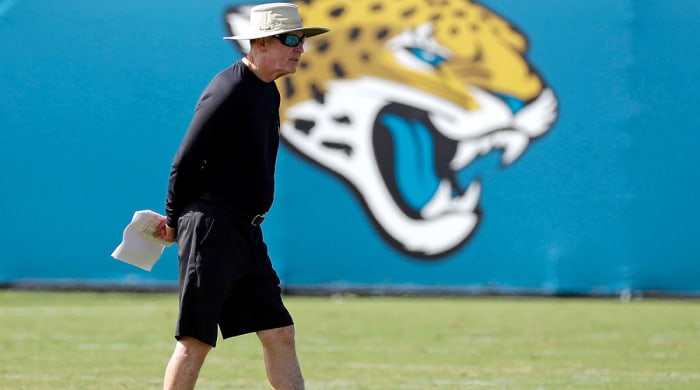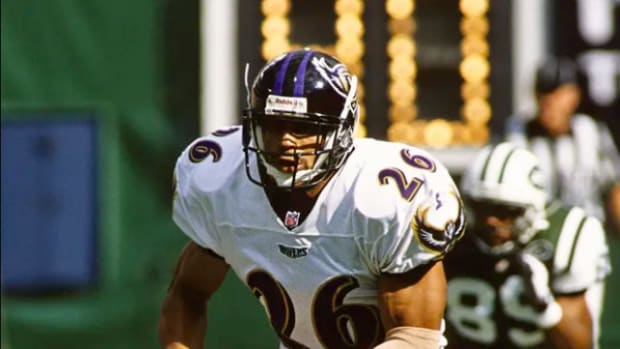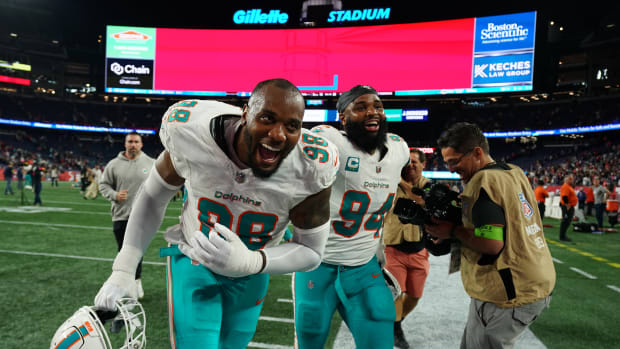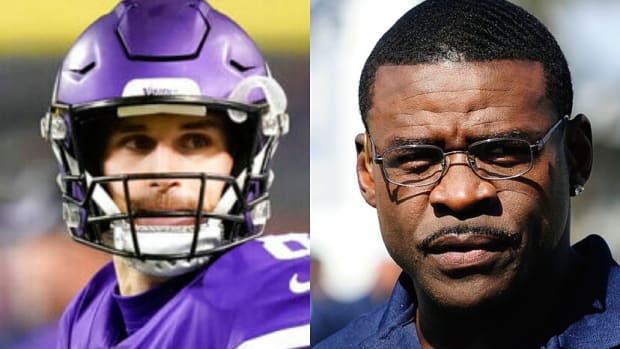Tom Coughlin’s Journey Continues in Jacksonville
This story appears in the Sept. 10, 2018, issue of Sports Illustrated. For more great storytelling and in-depth analysis, subscribe to the magazine—and get up to 94% off the cover price. Click here for more.
Don’t get confused: Tom Coughlin is not the coach of the Jaguars. He just inhabits what had been the coach’s office at TIAA Bank Field in Jacksonville, maintains a coach’s diet of meetings and film sessions, wields a coach’s glare at practices and is generally addressed as, well, Coach. And on this midsummer’s morning Coughlin is displaying the endless vigor necessary to succeed at the job he doesn’t have.
The 71-year-old executive vice president of football operations is explaining how he got here. And while his voice stays controlled, his right hand repeatedly pounds the table in front of him, emphasizing the key moments of his journey.
Between 2012 and ’16 the Jags won just 17 games, three fewer than any other NFL team. Their quarterback was the butt of a recurring joke on an NBC sitcom. The whole city, in the words of its mayor, had become “a punching bag.” And that’s where Coughlin begins his story, in December 2016, when he met with Shad Khan on the team owner’s $200 million yacht. “It was a nice visit,” Coughlin says, but “not what you would call your typical interview-type visit.”
Coughlin was at the top of Khan’s list to replace coach Gus Bradley—but Coughlin called back later that week, after their meeting, and floated something else instead. “I said, ‘Look,’” Coughlin recalls, and here his right hand thumps the white plastic table. “‘I think I can help you [thump!] as the owner. I can help the head coach [thump!]. I can help the personnel people. I can help any [thump!] number [thump!] of people [thump!] within the organization [thump!] to do their job better [thump!] because [thump!] of the experiences I’ve had. And my interest [thump!] is sincere.’”
His hand comes to a rest. “I mean, stop and think about it,” he says. “I started this thing.”

In eight years with the expansion Jaguars, Tom Coughlin led the team to the playoffs four times and the AFC Championship Game twice.
John Raoux/AP/Shutterstock
Coughlin’s journey didn’t begin on a luxury ship with a four-story elevator, two helipads and a sauna. It started in a trailer. And to truly appreciate this return saga—a potential classic, depending on the ending—you need to go back. To understand why he is succeeding, you have to know how he failed.
Coughlin left Boston College in 1994 to help build the expansion Jaguars because he loved football history, and because he hoped to write its next chapter. He revered Tom Landry, who coached the Cowboys during their inaugural season, in ’60, and then won two Super Bowls over 29 years in Dallas. Coughlin wanted to do that himself.
Arriving in Jacksonville, he didn’t have a desk in the team’s trailer-cum-headquarters, so he’d borrow owner Wayne Weaver’s. But as de facto general manager he did have total control over draft picks, free agents, even the color of the walls inside the new stadium. Time itself was under Coughlin’s thumb; he turned clocks in the Jaguars’ complex five minutes ahead to instill discipline. No white socks, he told players. They don’t look professional. No sunglasses, he told coaches. They’re a sign of weakness. “Discipline,” he would say, “is as important to the athlete as the air he breathes.”
And his teams won. In their second season the Jags went 9–7, upset a couple of AFC contenders and reached the conference championship game. Three years later they were a league-best 14–2 . . . and then came finishes of 7–9, 6–10 and 6–10. That was it for Coughlin, a victim of self-inflicted salary-cap disorder. As GM he had gone for broke; as coach he found himself $23 million over the cap before his final season, which meant 10 starters had to walk. That was that.
The postscript was unflattering. Players had groused under a leader whom even the AP called “autocratic” in reporting his firing. Simply put: Tom Landry 2.0 didn’t fly in the 2000s. Relationships couldn’t be one-way. Organizations couldn’t be run by one man (not named Bill Belichick). Coughlin would need to learn all of that before he could return.
He smarted for a year. He visited Italy and spent time with his grandkids. He turned down the job as Cowboys offensive coordinator under Bill Parcells—he was a head coach. He updated his list of people he wanted to work with and accepted that he didn’t need total control over personnel—and then he landed in 2004 with the Giants, who already had a GM. Coughlin wouldn’t build a franchise, but he would mold the No. 1 pick, quarterback Eli Manning. He had three O.K. years, averaging 8.3 wins, and then came a breakthrough.
Coughlin had heard players’ complaints about his intensity for years. Even his family had suggested he show more of his fun side at work. And so he conceded, finally, “I may be a dinosaur, but I can change.” He brought reporters into his office and asked what he could do better. He established a leadership council of players, took his team bowling and held a casino night in the stadium. Little things, you would think, but the results suggested otherwise. Six months after bowling night, Tom Coughlin was a Super Bowl champion. In 2011 he matched Landry’s two rings.
10 Thoughts on the 2018 Jacksonville Jaguars, Who Have Legitimate Super Bowl Aspirations
Soon came the exact same downswing—7–9, 6–10 and 6–10—and another forced exit. Even though he’d worked to relate to his players, going so far as scheduling a symposium on millennials’ learning styles, it hadn’t been enough. Coughlin’s game-calling came into question when New York lost leads in the final 75 seconds of six games in 2015; the team’s defense also plummeted to 32nd. Suddenly, in ’16, he was back on the sidelines’ sidelines.
To keep busy, he became a senior adviser in the league office. And while it wasn’t exactly football, his time in New York City was instructive. He showed up regularly on Sundays to watch from the league’s replay nerve center, where he got to see how officiating czar Dean Blandino managed his team of refs from afar each game day—in charge, even without control over every call. Coughlin also communicated with teams while surveying coaches for the league, learning how their power structures differed. Thirteen years after relinquishing his need to control personnel, he decided it would be O.K. if he didn’t coach. He could oversee both aspects of an organization without having to micromanage them. In New Jersey, he’d learned how to relate. In New York, he got a reminder about how to lead.
Often during those marathon Sundays with Blandino, Coughlin would hover in front of the Giants’ game. Or the Jaguars’. He had been fired 14 years earlier, but Coughlin never left Jacksonville. Not totally. On the day he was let go, in 2002, he got a call from Jacksonville pediatric oncologist Michael Joyce. “I just want you to know,” Joyce said, “if the Jay Fund is not here, I don’t know what these families are going to do.” Coughlin had started the Jay Fund Foundation in 1996 to help parents dealing with childhood cancer—in memory of Jay McGillis, a BC safety who died in ’92 after battling leukemia—and he decided to keep it running even after he moved on. His daughter Keli took over as executive director and grew the program. Tom and his wife, Judy, had kept their beachfront property, planning to build their retirement home.
Then Khan called back; he was on board with Coughlin’s proposal. If he was truly ready to lead from off the field, there wouldn’t be a better fit than this.
Jeff Lageman had his doubts. And he wasn’t alone. After playing defensive end for Coughlin from 1995 to ’98 and seeing how his old coach asserted control over everything from socks to clocks, it was fair to wonder whether he would be able to collaborate with coach Doug Marrone. But the potential upside quickly became clear, even if Coughlin wasn’t wearing a coach’s whistle. “The minute he was hired, everybody in the building was nervous,” Lageman recalls. “Where people might’ve come to work wearing jeans and a golf shirt, all of a sudden they were wearing button-downs and khakis.”
Defensive tackle Malik Jackson remembers vividly that first camp of Coughlin’s new regime. “It was definitely the hardest thing I’ve ever been a part of,” he says. The heat, the pads, the yelling—it all led to scuffles and complaints. “I mean, f---, the whole camp was like, This s--- sucks.” Jackson recalls. “Every day. What the f---?”
Jacksonville fans had been waiting to hear those grumbles again. “This is a military town,” says Brian Coughlin, one of Tom’s two sons. “They love structure and organization. They love to know the head guy isn’t a player’s coach.”
Bob Wylie, Hard Knocks’ Breakout Star, Gets One More Moment in the Limelight
Lenny Curry is one of those Jaguars fans. He keeps a Blake Bortles–signed helmet on his shelf and can practically recite Coughlin’s second book, Earn the Right to Win, from memory. He’s also the mayor of Jacksonville. “You read that book and you can literally see, as the season progresses, that stuff happening,” he says in the city hall office where he keeps a throwing net in the corner. “Folks that pay attention could see something special coming.”
Those folks watched the Jaguars beat the Texans 29–7 on the road in their 2017 opener and started to wonder. Jacksonville took down the Steelers 30–9, and they began to hope; the Seahawks 30–24, and they believed. Fans tuned in again. They dug out their 1990s Jags hats and T-shirts and even started showing up, allowing the team to remove the tarps that had been draped across 3,000 seats in the lean years.
They also got a taste of the new Coughlin. He let Marrone wear shades during training camp—and then donned a pair himself. In Week 3, after Donald Trump railed out against players kneeling during the national anthem, Coughlin met on Sunday morning with Khan and Marrone to discuss how the team ought to carry itself before facing the Ravens in London, the first matchup of the day. Coughlin warned: You have to understand where these players came from, their -upbringing—and if you don’t, the team will fall apart. The front-office group met with players, and together they ultimately decided the team would lock arms during the anthem.
The Jaguars hosted a playoff game for the first time in 18 years, won that playoff game, traveled to Pittsburgh and won again. “We were all emotional,” says center Brandon Linder. “We’d all been there in the worst of times. S---, the years when we were just losing, [that was] just dysfunction. So it was nice to turn a leaf.”
Thump! Coughlin’s palms slam the table simultaneously. This isn’t emphasis—it’s pure frustration. You want to know what he thought about after the 24–20 loss in New England the next week? Really?
“The game—what else?! The fourth quarter. Up 10. Myles Jack’s [return of a fumble],” which was blown dead before the Jaguars linebacker could walk in for an easy touchdown. “I called the league office,” says Coughlin, “and went over this for a hundredth time. Let. The. Play. Go.” The coach transports himself back to that conversation, not long after the final whistle of the AFC title game. New York agreed, he says. The referee shouldn’t have called the play dead—he’s remorseful. “Oh really!?” Coughlin replies, then and now. “We’re just a little bit remorseful down here, too.”
The Jaguars handled this offseason like contenders in it for the long haul. Coughlin has final say over personnel, but each move was a “collective decision,” a “team effort” with Marrone and GM Dave Caldwell. They wooed and landed a top-tier free agent, Panthers guard Andrew Norwell, who cited the team’s atmosphere and leadership in explaining his decision, but they let more (well-paid) veterans walk than they signed. In the draft, they added (cheap) depth at two of their strongest units: defensive line and secondary. They re-signed Bortles instead of gambling on a rookie QB or a high-priced veteran. And for the first time in who-knows-how-long, there was not a hot seat in the building. Not in Coughlin’s two-room lair, stuffed as it is with mementos collected over five decades of coaching. Not in Marrone’s more spartan office, where the style is best described as binder chic.
Back in January 2017, a generation after Coughlin had arrived in Jacksonville with full control, Khan told Marrone he’d like to promote him from interim head coach—but only if he was willing to report to Coughlin. “Holy s---, that’s great!” Marrone responded (thinking to himself, Maybe I shouldn’t have just said the S-word). This was far from a shotgun arrangement. Marrone had long looked up to Coughlin; when he’d coached at Syracuse, and later led the Bills, Marrone would meet with Coughlin every offseason, regularly following up for advice. Part of Coughlin’s plan to return was having Marrone there with him. “So when we got together here, things were in place,” says Marrone.
Together they sneered at the players’ plush locker room, ripping out the Ping-Pong table and shuffling locker locations to break up cliques and spread out leaders. If that didn’t set the tone, the new color they chose for the tunnels around the locker room—black—certainly did. They plastered inspirational words like grit in specific spots so players would see them every time they entered a meeting or training session, and they hung the team’s divisional schedule directly outside the locker room. It wasn’t just a matter of who made decisions around the building. They decided.
And they have kept up the strictness. Training camp this August was just as grueling as in year one—“maybe harder,” Coughlin says with a small grin. Star corner Jalen Ramsey and defensive end Dante Fowler were each suspended for a game for violating team rules, though Marrone and Coughlin haven’t discussed that decision publicly. The players needed discipline then; the team doesn’t need distraction now.
Coughlin had told NFL.com in training camp that first summer that he would only be staying late at the facility one night a week and that he wouldn’t sit in on meetings. But it didn’t play out that way. “I’m [with the team] on Saturday night,” Coughlin says one year later. “There’s never been an executive who went to the Saturday night with the team. That’s just me. What do you want me to do? I eat, I go to meetings—just like I did when I was a head coach.”
He watches tape the same way he always has, too, flagging certain plays and sending them to position coaches for review. “They know where it came from,” Coughlin says.
The typical head job is a lonely one, single-handedly managing each week’s demands, stopping all of the bucks yourself. But not with Coach around. “We talk constantly,” the 54-year-old Marrone says. “I work for him and I love it.”
Coughlin’s story ends with the present—the upcoming season, the chance to finally push Jacksonville to a Super Bowl, to respectability—but it also connects to the past, to the topic he least wants to discuss: the Giants. He won’t talk about Odell Beckham Jr. He declines to describe his reaction to Eli Manning’s benching last December. He reveals only that he texts with Giants owner John Mara sparingly. But these topics have been unavoidable. Back in May, when he paid a visit to some Jay Fund families, a 10-year-old patient dealing with leukemia asked, “How do you feel about the Jaguars and Giants [playing] each other the first game of the season?” Coughlin chuckled. “Believe me,” he said, “that is a setup. I think the league kind of wanted to see that [game] take place.”
A different football lifer might consider the upcoming reunion more meaningful. For someone who has spent his life always moving, chasing, coaching, it could be an opportunity to reflect—a chance to sit back and see all that he has built. But not Coughlin.
On the Saturday before the matchup in the Meadowlands, he will wake up, get breakfast, go to meetings and pray, just as he always has. Later, he’ll retreat to his room before falling asleep to whatever college football game is on. On Sunday, Coughlin won’t be pacing the sideline he ruled for a decade. But Jags and Giants fans still know what to expect from Coach: an afternoon of banging the table and yelling about the refs.
That’s just Tom Coughlin. What do you want him to do?
• Question or comment? Email us at talkback@themmqb.com.





































